An Oil Giant Is No Match for Resistance and Resilience in Richmond, California
How a small Laotian refugee community on San Francisco Bay took on Chevron, won—and keeps winning.
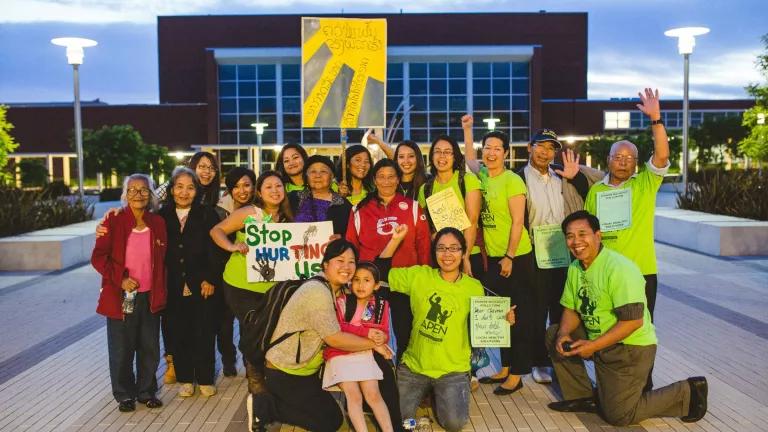
Torm Nompraseurt (front row, far right), APEN’s senior Richmond community organizer, and APEN members at a hearing on Chevron's environmental impact report in 2014
Courtesy of APEN
Torm Nompraseurt didn’t intend to become an environmental justice leader. When a fledgling organization called Asian Pacific Environmental Network (APEN) approached him in 1995 about advocating for the Laotian community in Richmond, California, he sent them a list of 20 candidates to consider for the job. A few weeks later, APEN returned. They told him that every one of those people had insisted he was the one to hire.
Nompraseurt believes he was the first Laotian refugee to arrive in Richmond in 1975, after fleeing the Vietnam War. Since then, he’s dedicated himself to helping his fellow refugees—a community that APEN leaders estimate encompasses some 10,000 Laotians in western Contra Costa County, with most residing in the city of Richmond. When APEN asked him again to join their team, he recalls, “I decided I wanted to fight for my community.”
APEN and Nompraseurt, now APEN’s senior Richmond community organizer, faced a steep challenge. Located 17 miles north of San Francisco, across the Bay, Richmond is a small, working-class city where residents—predominantly people of color—live surrounded by heavy industry: More than 350 refineries and other fossil fuel companies are based here. Together, they contribute to more than 100 hazardous waste sites within its boundaries.
The sprawling, 2,900-acre Chevron refinery is one of the largest and oldest on the West Coast, having set up shop in 1902 as Standard Oil. Pollution from the refinery has taken a toll on the health of the community and on the surrounding waters, with many dangerous incidents occurring throughout the years. Among the most notorious in its recent history, a 2012 explosion sent 15,000 people to seek medical attention in respiratory distress. And just this past February, an oil leak spilled nearly 600 gallons into the Bay. Meanwhile, Richmond’s rate of childhood asthma is 17 percent, more than double the national average. The city also has high rates of cancer, respiratory illnesses, autoimmune disorders, and other ailments.
“People thought it was a good idea at the time to have all this heavy industry,” says Gayle McLaughlin, former mayor and current city councilwoman of Richmond. “It was a hallmark of the 20th century. But now we’re paying the price.”

Building a Grassroots Movement
In March 1999, an explosion at the Chevron refinery spewed smoke across the county. The city’s emergency telephone service sent out shelter-in-place warnings—but only in English. For the Laotian refugee community, many of whom had limited understanding of English, these warnings were insufficient. Several people went outside to investigate, breathing in the noxious fumes. In all, more than 2,500 Richmond residents ended up in the hospital.
APEN recognized the need for a multilingual warning system, specifically in Mien, Khmu, and Lao. But first, organizers realized, they’d need to address something even more fundamental: multilayers of trauma.
“Back in Laos, if you say something or complain, you can get your head chopped off, or go to jail forever,” explains Nompraseurt. As refugees, the Laotians had experienced oppression, war, refugee camps, and multiple displacements. During a postcard-writing campaign meant to encourage local officials to support the initiative to create the multilingual system, it became clear that many community members were reluctant to advocate for themselves. “When they asked where we were sending them to, and we said the county, they got really scared, saying, ‘Oh, no no no! They will take my SSI [supplemental security income] benefit!’ But I assured them. I told them, it will give your SSI more power—community power.”
Because Nompraseurt and others at APEN were trusted leaders, the residents eventually agreed to not only sign the postcards but also provide in-person testimony. They were prepped and given translators. Still, some visibly shook in front of the county supervisory board. When the board approved the multilingual warning system and the team posed for a victory photo outside, one participant, nearly 70 years old, whispered into Nompraseurt’s ear: “You know? I almost peed in my pants back in there.” Then she grinned. “But now? My face is bigger than the moon!”

Since then, the Laotian community, through APEN, has become an organizing force, and they’ve been instrumental in passing a series of bills to mitigate pollution. When Chevron wanted to expand its refinery in 2005, APEN, along with a coalition of other organizations like Communities for a Better Environment (CBE), packed the public hearings. When that didn’t sway the city council, the coalition filed a lawsuit in 2008—and won. And in May 2018, Chevron agreed to a $5 million settlement for the catastrophic explosion of 2012.
In the process, APEN learned a critical lesson. “For many years, Chevron has been polluting not just the air, the environment, and people’s bodies,” says Vivian Yi Huang, deputy director of APEN. “It’s been polluting democracy.”
Community v. Refinery
Chevron is Richmond’s largest source of tax income. But even that benefit comes laced with inequity. Decades ago, a Chevron-backed city council wrote a clause into the utility user tax ordinance radically limiting the city’s authority to tax the refinery. “Essentially, it said that the largest rate payer in the city gets to establish its own tax rate,” says Andrés Soto, the Richmond community organizer for CBE. Instead of paying the standard percentage rate that other utilities paid, Chevron could afford to choose the “maximum tax” alternative, which basically amounted to a flat fee. And Chevron paid this set amount from the 1980s well into the new millennium.
Local organizers rallied to change this. “We’re talking about fair taxation,” says McLaughlin. “Not just in terms of Chevron’s huge profits—we want to hold them accountable for the risks they present to our community.” In 2008, the coalition was able to get a large manufacturers’ tax onto the ballot—and it passed. Chevron contested it and a judge struck it down, but in 2010, after further efforts from the city and local organizers, the company agreed to a settlement that included $114 million.
The coalition celebrated the progress but kept its eyes on the bigger picture: To effect deeper change, they knew they’d have to transform the government. In 2020, in the midst of the COVID-19 pandemic, the coalition worked with the Richmond Progressive Alliance, as it had since 2004, to elect a slate of city council candidates who didn’t accept corporate funding. Through several election cycles, Chevron spent millions to counter their effort while putting forth its own candidates.
“Chevron is a multinational, multibillion-dollar corporation,” says Huang. “But the community members in Richmond have been so amazingly powerful, and they’re not backing away from that—or backing down.” And organizing has been at the heart of every success. APEN’s slogan as it got out the vote was “When we organize, we win.” And they did. Every one of the candidates APEN Action supported now sits on the city council.

Looking ahead, Richmond organizations are focused on a just transition away from fossil fuels. “We’re pushing for decommissioning of the refinery,” says Soto, “but we want to ensure that when Chevron shuts down, it cleans up the contamination left behind.”
In the toxic tours that he sometimes leads, Soto takes people down to what he calls the “Dirtiest Street in Richmond” to point out the concentration of polluters on just a single block: the CEMEX cement plant, the Levin-Richmond coal and petcoke terminal (which organizers succeeded in banning in 2020), and the Sims Metal recycling plant (which caught fire in 2018; NRDC and others filed a brief in January calling for stronger oversight statewide).
The tour continues to the AstraZeneca waste dump, which Soto calls “one of the most toxic stews in the state of California.” And yet, the previous city council voted to clear the way for a 4,000-unit housing project on the site. Soto and his fellow advocates are working with the new council to ensure a thorough cleanup takes priority.
There’s also the issue of the economic impact of decommissioning. “These companies can’t refine forever,” McLaughlin points out. “There’s limited oil in the ground, and one day, if they just decide to close up, that’s going to leave a big hole in the city’s general fund.” Organizers are pushing the city to hold the polluters accountable for future remediation and transition. Meanwhile, McLaughlin notes, there’s a parallel need for more business development, especially in the clean energy sector. The city has made some progress already on this front. In 2014, in an agreement with the city and local clean electricity provider MCE, Chevron provided 60 acres for a 10.5-megawatt solar farm on its remediated brownfield, which serves some 3,900 MCE customers and is the largest municipal solar field in the Bay Area. And more sustainable local businesses are cropping up too—like Rich City Rides, “a bike shop with a mission” that promotes cycling through events and programs, and Urban Tilth, which hires and trains community members to build sustainable urban farms.
Passing the Torch
Despite the dominance of industry and increasing private interests, residents are dedicated to realizing their vision of a just, livable, healthier Richmond—for both themselves and future generations. With many Laotian elders retiring, Denny Khamphanthong, APEN’s Richmond community organizer, is engaging working-age activists to carry on the advocacy, not just for holding the polluters accountable but also for driving action on climate resiliency, stable housing, and sustainable jobs. “It’s a process, teaching people about the power dynamics in the city and helping them understand a system we were never meant to understand,” he says. “We are reclaiming what it means to feel ‘safe’ in our own city.” That includes organizing and supporting youth leadership: In 2018, APEN worked closely with community group RYSE and other Richmond organizations in passing Measure H, which establishes funding for a Richmond Kids First initiative that seeks to address the structural and environmental conditions that drive harmful behavior in children.
For local families, the new Unity Park, with its playgrounds, basketball courts, and bike paths is a step toward that goal. Designed with community input and led by the work of Urban Tilth and more than 20 other organizations, the 7.5-acre park, completed in 2018, embodies what Richmond’s better future could look like. In addition to its recreational spaces, it also features a plethora of gardens—for growing vegetables and fruits, attracting pollinators, and capturing runoff.
Soto ends his toxic tours at Unity Park and reflects on how far the city has come since its environmental justice movement first took hold. “Richmond has a long history now of resistance and resilience,” he says. “It’s why I call my tours the Toxics & Resilience Tour.”
This NRDC.org story is available for online republication by news media outlets or nonprofits under these conditions: The writer(s) must be credited with a byline; you must note prominently that the story was originally published by NRDC.org and link to the original; the story cannot be edited (beyond simple things such as grammar); you can’t resell the story in any form or grant republishing rights to other outlets; you can’t republish our material wholesale or automatically—you need to select stories individually; you can’t republish the photos or graphics on our site without specific permission; you should drop us a note to let us know when you’ve used one of our stories.
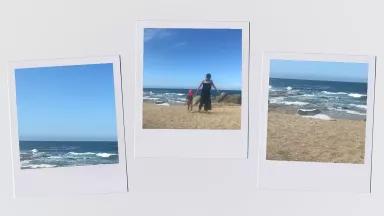
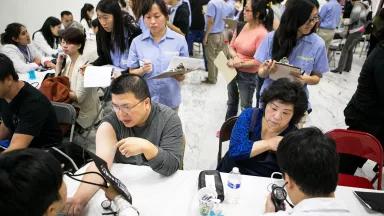
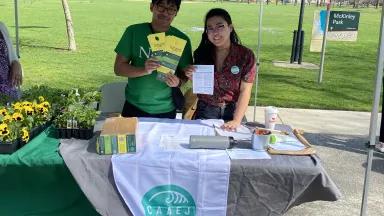
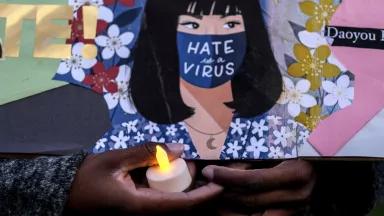
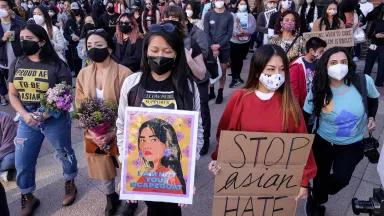

Will Los Angeles Finally Put an End to Oil Drilling in Neighborhoods?
Six Ways to Help End Neighborhood Oil Drilling in California
Fossil Fuel Air Pollution Kills One in Five People